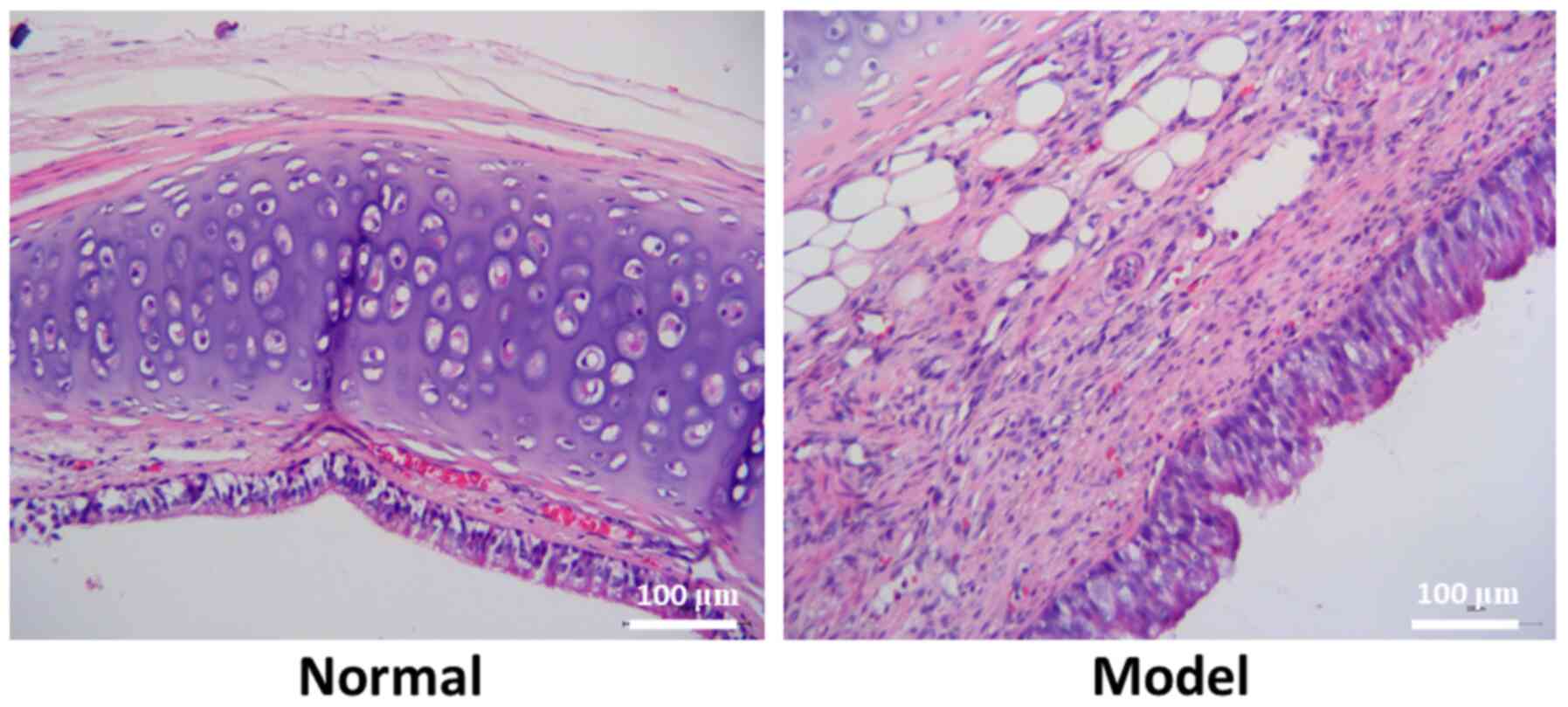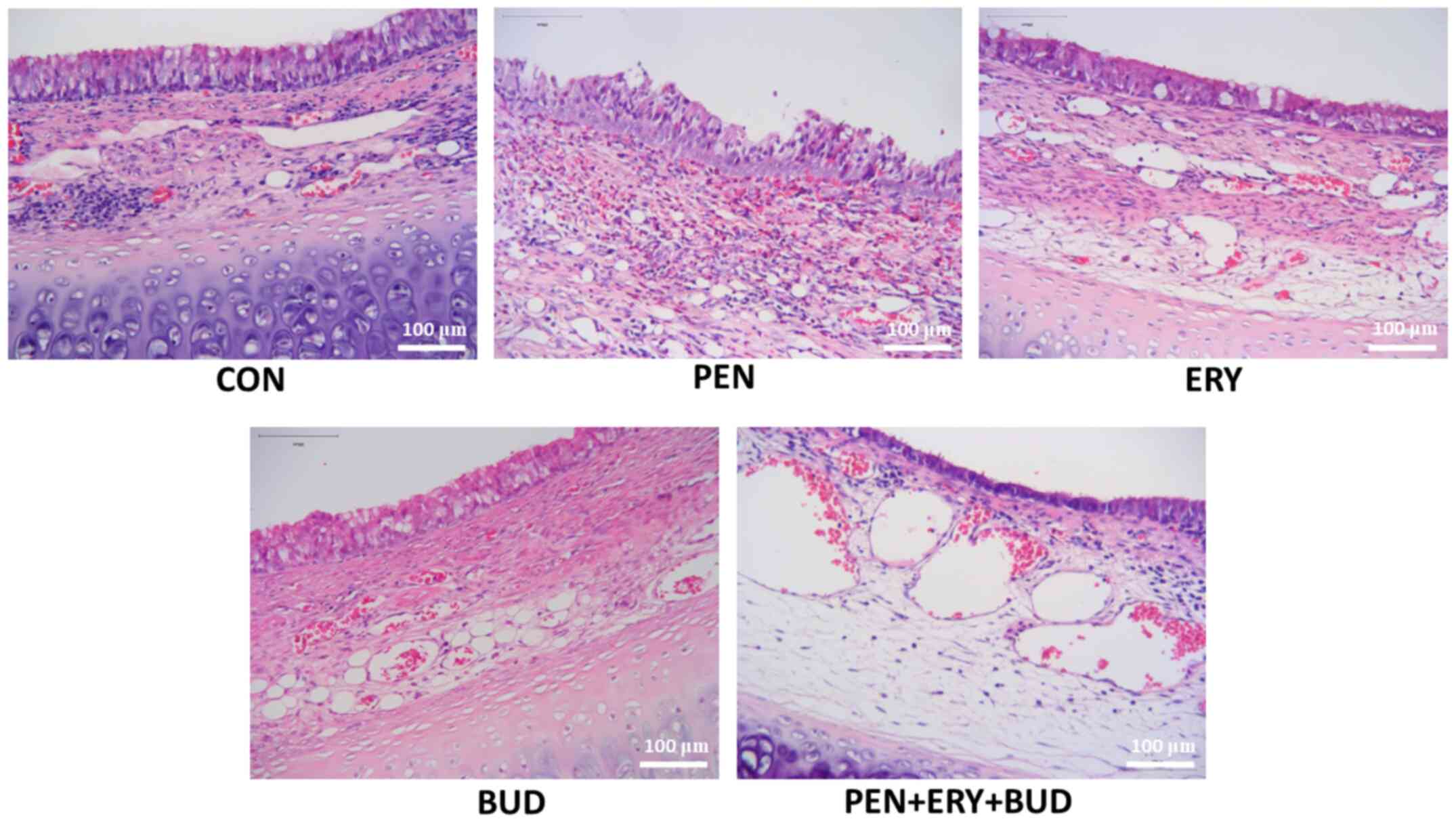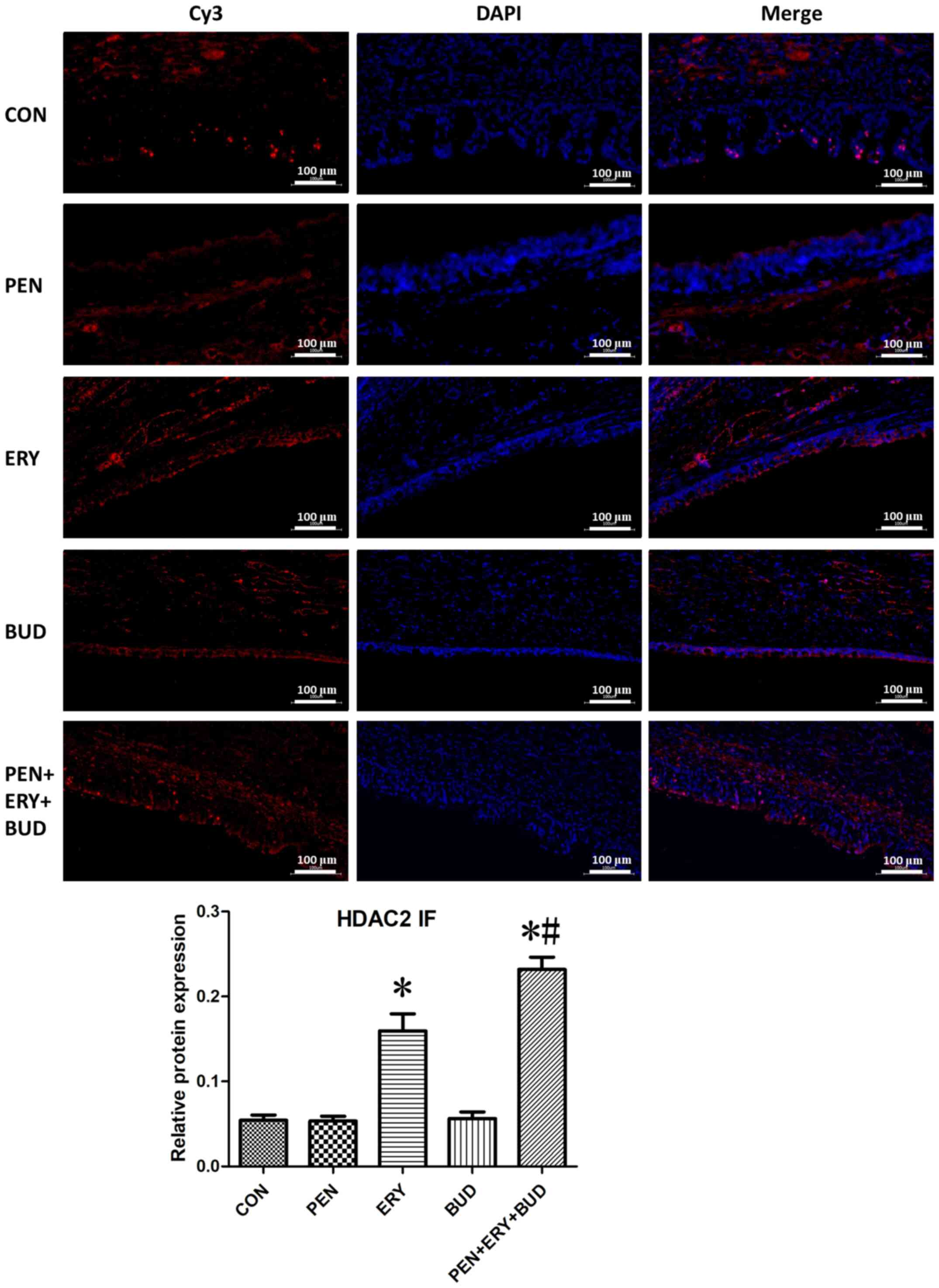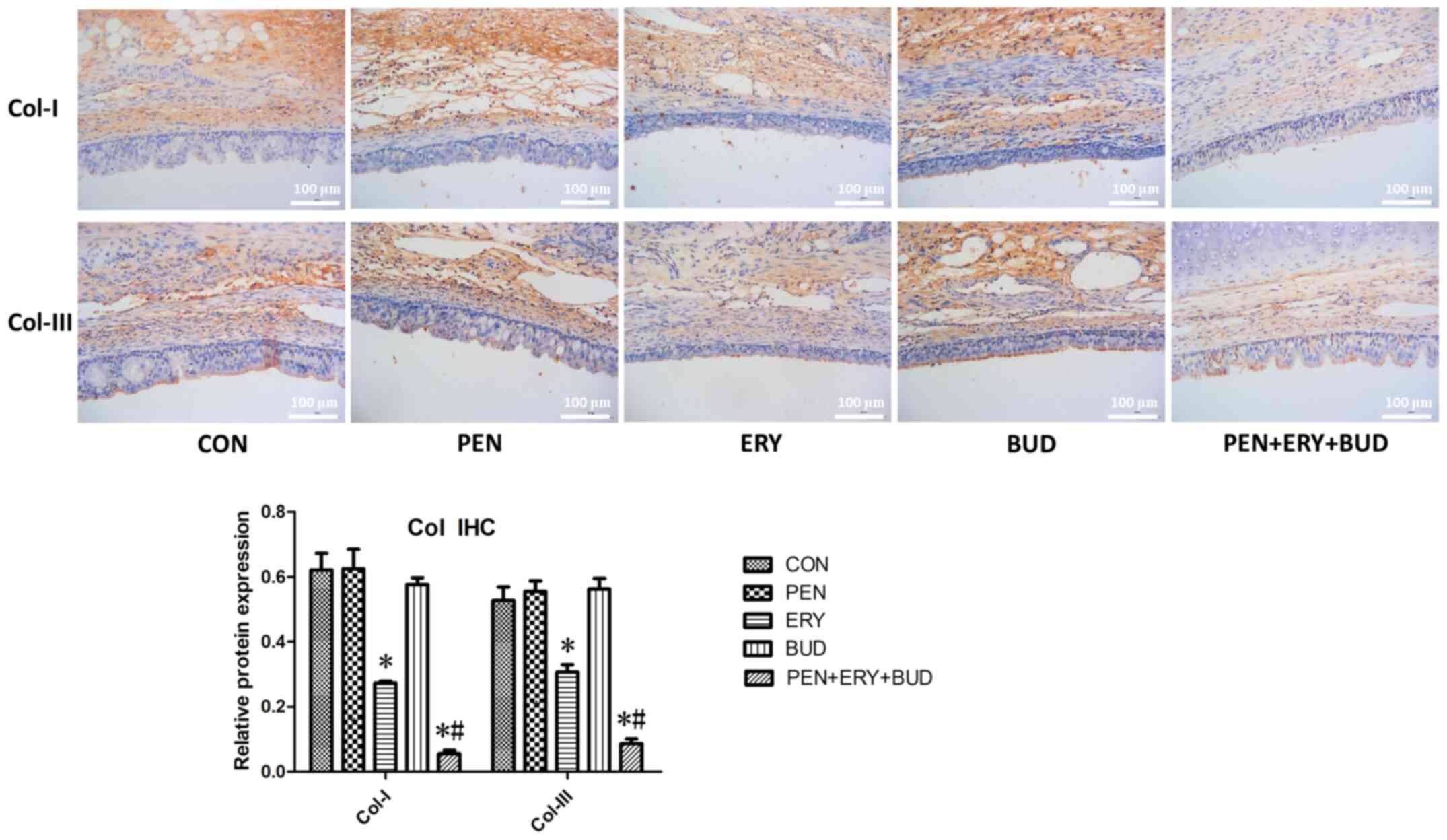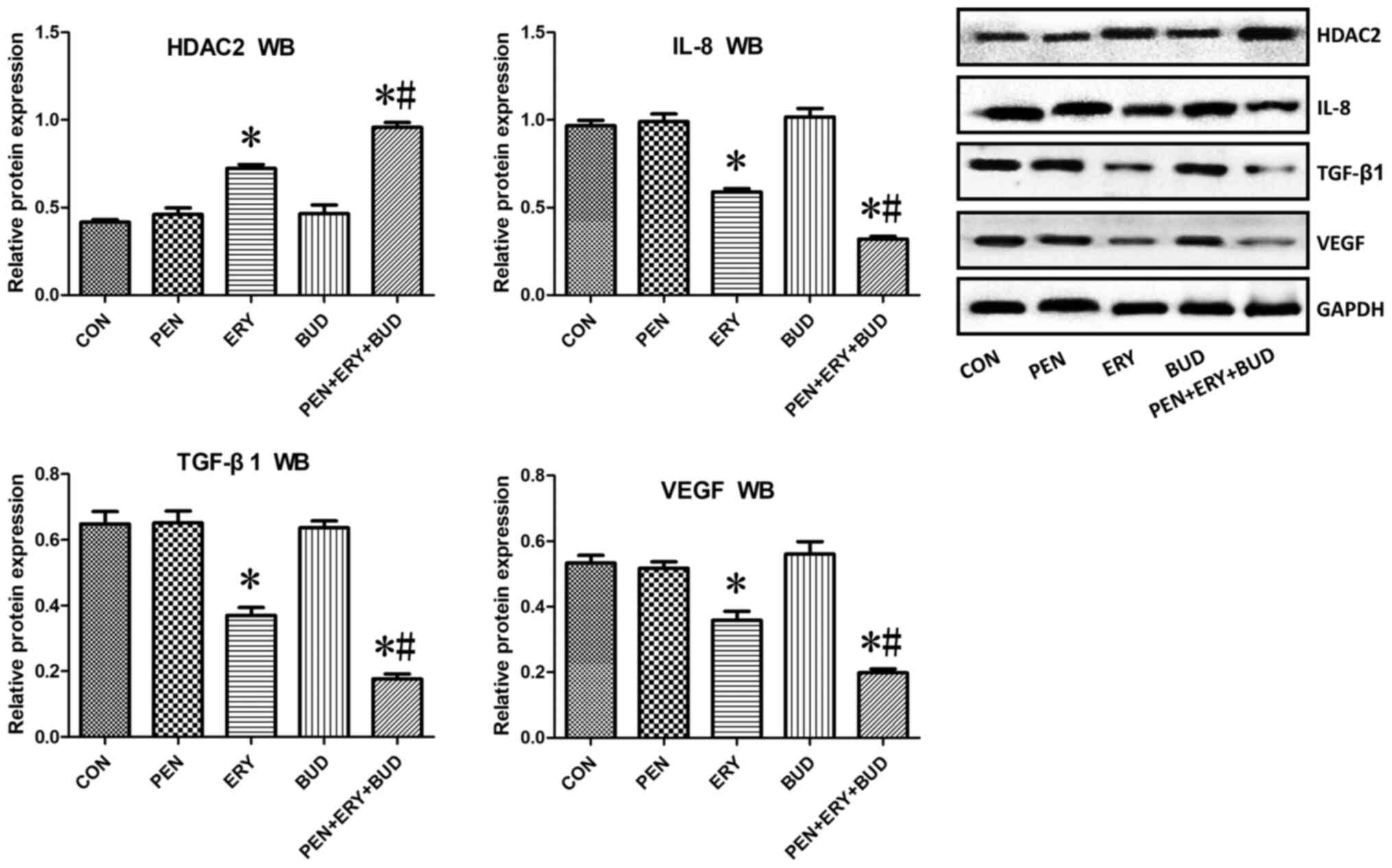|
1
|
Su ZQ, Wei XQ, Zhong CH, Chen XB, Luo WZ,
Guo WL, Wang YZ and Li SY: The cause and efficacy of benign
tracheal stenosis. Zhonghua Jie He He Hu Xi Za Zhi. 36:651–654.
2013.(In Chinese). PubMed/NCBI
|
|
2
|
Zhang J, Wang T, Wang J, Pei YH, Xu M,
Wang YL, Zhang X and Wang C: Effect of three interventional
bronchoscopic methods on tracheal stenosis and the formation of
granulation tissues in dogs. Chin Med J (Engl). 123:621–627.
2010.PubMed/NCBI
|
|
3
|
Puyo CA and Dahms TE: Innate immunity
mediating inflammation secondary to endotracheal intubation. Arch
Otolaryngol Head Neck Surg. 138:854–858. 2012. View Article : Google Scholar : PubMed/NCBI
|
|
4
|
Lawrence DA, Branson B, Oliva I and
Rubinowitz A: The wonderful world of the windpipe: A review of
central airway anatomy and pathology. Can Assoc Radiol J. 66:30–43.
2015. View Article : Google Scholar : PubMed/NCBI
|
|
5
|
Li LH, Xu MP, Gan LM, Li Y, Liang YL, Li
WT, Qin EY, Gan JH and Liu GN: Effect of low dose erythromycin on
the proliferation of granulation tissue after tracheal injury.
Zhonghua Yi Xue Za Zhi. 97:777–781. 2017.(In Chinese). PubMed/NCBI
|
|
6
|
Yao H and Rahman I: Current concepts on
oxidative/carbonyl stress, inflammation and epigenetics in
pathogenesis of chronic obstructive pulmonary disease. Toxicol Appl
Pharmacol. 254:72–85. 2011. View Article : Google Scholar : PubMed/NCBI
|
|
7
|
Ito K, Lim S, Caramori G, Chung KF, Barnes
PJ and Adcock IM: Cigarette smoking reduces histone deacetylase 2
expression, enhances cytokine expression, and inhibits
glucocorticoid actions in alveolar macrophages. FASEB J.
15:1110–1112. 2001. View Article : Google Scholar : PubMed/NCBI
|
|
8
|
Barnes PJ: Role of HDAC2 in the
pathophysiology of COPD. Annu Rev Physiol. 71:451–464. 2009.
View Article : Google Scholar : PubMed/NCBI
|
|
9
|
Croft CB, Zub K and Borowiecki B: Therapy
of iatrogenic subglottic stenosis: A steroid/antibiotic regimen.
Laryngoscope. 89:482–489. 1979. View Article : Google Scholar : PubMed/NCBI
|
|
10
|
Zhou L, Li Y, Gan LM, Qin EY, Meng XY, Gan
JH, Li WT, Qin CC and Liu GN: Effects of different drugs on
bronchial stenosis by TGF-β/mTOR signaling pathway in rabbit model.
Zhonghua Yi Xue Za Zhi. 99:1898–1903. 2019.(In Chinese). PubMed/NCBI
|
|
11
|
Thompson SR III: Treatment of syphilis in
pregnancy. J Am Vener Dis Assoc. 3:158–167. 1976.PubMed/NCBI
|
|
12
|
Giamarellos-Bourboulis EJ: Macrolides
beyond the conventional antimicrobials: A class of potent
immunomodulators. Int J Antimicrob Agents. 31:12–20. 2008.
View Article : Google Scholar : PubMed/NCBI
|
|
13
|
Stern A, Skalsky K, Avni T, Carrara E,
Leibovici L and Paul M: Corticosteroids for pneumonia. Cochrane
Database Syst Rev. 12:CD0077202017.PubMed/NCBI
|
|
14
|
Kilkenny C, Browne WJ, Cuthill IC, Emerson
M and Altman DG: Improving bioscience research reporting: The
ARRIVE guidelines for reporting animal research. J Pharmacol
Pharmacother. 1:94–99. 2010. View Article : Google Scholar : PubMed/NCBI
|
|
15
|
Nakagishi Y, Morimoto Y, Fujita M, Ozeki
Y, Maehara T and Kikuchi M: Rabbit model of airway stenosis induced
by scraping of the tracheal mucosa. Laryngoscope. 115:1087–1092.
2005. View Article : Google Scholar : PubMed/NCBI
|
|
16
|
White WJ and Field KJ: Anesthesia and
surgery of laboratory animals. Vet Clin North Am Small Anim Pract.
17:989–1017. 1987. View Article : Google Scholar : PubMed/NCBI
|
|
17
|
Harken AH, Lillo RS and Haut MJ: The
depressant influence of extracellular fluid hyperoxia on liver
slice oxygen uptake. J Lab Clin Med. 89:1269–1277. 1977.PubMed/NCBI
|
|
18
|
Spiers DE and Candas V: Relationship of
skin surface area to body mass in the immature rat: A
reexamination. J Appl Physiol Respir Environ Exerc Physiol.
56:240–243. 1984.PubMed/NCBI
|
|
19
|
Lei H, Qian GS, Wu GM and Huang GJ:
Transfection of human beta defensin 2 gene into the lung by aerosol
inhalation: Experiment with rats. Zhonghua Yi Xue Za Zhi.
88:1425–1428. 2008.(In Chinese). PubMed/NCBI
|
|
20
|
Lin JT, Zhang YM, Zhou X, Wang CZ, Huang
M, Liu CT, Wu CG, Wan HY, Yu WC and Dai YR: Chinese expert
consensus for non-antiinfective effects and clinical use of
macrolides. Zhonghua Nei Ke Za Zhi. 56:546–557. 2017.(In Chinese).
PubMed/NCBI
|
|
21
|
Ushida K, Asai N, Uchiyama K, Enomoto A
and Takahashi M: Development of a method to preliminarily embed
tissue samples using low melting temperature fish gelatin before
sectioning: A technical note. Pathol Int. 68:241–245. 2018.
View Article : Google Scholar : PubMed/NCBI
|
|
22
|
Stauffer JL, Olson DE and Petty TL:
Complications and consequences of endotracheal intubation and
tracheotomy. A prospective study of 150 critically ill adult
patients. Am J Med. 70:65–76. 1981. View Article : Google Scholar : PubMed/NCBI
|
|
23
|
Plojoux J, Laroumagne S, Vandemoortele T,
Astoul PJ, Thomas PA and Dutau H: Management of benign dynamic
‘A-shape’ tracheal stenosis: A retrospective study of 60 patients.
Ann Thorac Surg. 99:447–453. 2015. View Article : Google Scholar : PubMed/NCBI
|
|
24
|
Barros CD, Fernandez-Bussy S, Folch E,
Flandes AJ and Majid A: Non-malignant central airway obstruction.
Arch Bronconeumol. 50:345–354. 2014.(In English, Spanish).
View Article : Google Scholar : PubMed/NCBI
|
|
25
|
Zhang J, Wang J, Wang T, Xu M, Dang BW,
Pei YH and Zhang CY: A pilot study on interventional bronchoscopy
in the management of airway stenosis with benign hyperplasia.
Zhonghua Jie He He Hu Xi Za Zhi. 34:334–338. 2011.(In Chinese).
PubMed/NCBI
|
|
26
|
Ferreira S, Nogueira C, Oliveira A, Neves
S, Almeida J and Moura e Sá J: Bronchoscopic dilation techniques
and topical application of mitomycin-C in the treatment of tracheal
stenosis post intubation-two case reports. Rev Port Pneumol.
16:149–156. 2010.(In Portuguese). View Article : Google Scholar : PubMed/NCBI
|
|
27
|
Simpson CB and James JC: The efficacy of
mitomycin-C in the treatment of laryngotracheal stenosis.
Laryngoscope. 116:1923–1925. 2006. View Article : Google Scholar : PubMed/NCBI
|
|
28
|
Tendulkar RD, Fleming PA, Reddy CA, Gildea
TR, Machuzak M and Mehta AC: High-dose-rate endobronchial
brachytherapy for recurrent airway obstruction from hyperplastic
granulation tissue. Int J Radiat Oncol Biol Phys. 70:701–706. 2008.
View Article : Google Scholar : PubMed/NCBI
|
|
29
|
Zhu GH, Ng AH, Venkatraman SS, Boey FYC,
Wee ALY, Trasti SL and Lim LHY: A novel bioabsorbable drug-eluting
tracheal stent. Laryngoscope. 121:2234–2239. 2011. View Article : Google Scholar : PubMed/NCBI
|
|
30
|
Shin JH, Song HY, Seo TS, Yuk SH, Kim YH,
Cho YM, Choi GB, Kim TH and Suh JY: Influence of a
dexamethasone-eluting covered stent on tissue reaction: An
experimental study in a canine bronchial model. Eur Radiol.
15:1241–1249. 2005. View Article : Google Scholar : PubMed/NCBI
|
|
31
|
Venhaus M, Behn C, Freitag L and
Zimmermann K: Simulations and experiments of the balloon dilatation
of airway stenoses. Biomed Tech (Berl). 54:187–195. 2009.
View Article : Google Scholar : PubMed/NCBI
|
|
32
|
Erelel M, Yakar F and Yakar A:
Endobronchial tuberculosis with lobar obstruction successfully
treated by argon plasma coagulation. South Med J. 102:1078–1081.
2009. View Article : Google Scholar : PubMed/NCBI
|
|
33
|
Krimsky WS, Rodrigues MP, Malayaman N and
Sarkar S: Spray cryotherapy for the treatment of glottic and
subglottic stenosis. Laryngoscope. 120:473–477. 2010. View Article : Google Scholar : PubMed/NCBI
|
|
34
|
Brown MT and Montgomery WW: Microbiology
of tracheal granulation tissue associated with silicone airway
prostheses. Ann Otol Rhinol Laryngol. 105:624–627. 1996. View Article : Google Scholar : PubMed/NCBI
|
|
35
|
Simoni P and Wiatrak BJ: Microbiology of
stents in laryngotracheal reconstruction. Laryngoscope.
114:364–367. 2004. View Article : Google Scholar : PubMed/NCBI
|
|
36
|
Matt BH, Myer CR III, Harrison CJ, Reising
SF and Cotton RT: Tracheal granulation tissue. A study of
bacteriology. Arch Otolaryngol Head Neck Surg. 117:538–541. 1991.
View Article : Google Scholar : PubMed/NCBI
|
|
37
|
Barnes PJ: How corticosteroids control
inflammation: Quintiles Prize Lecture 2005. Br J Pharmacol.
148:245–254. 2006. View Article : Google Scholar : PubMed/NCBI
|
|
38
|
Yokoi A, Nakao M, Bitoh Y, Arai H, Oshima
Y and Nishijima E: Treatment of postoperative tracheal granulation
tissue with inhaled budesonide in congenital tracheal stenosis. J
Pediatr Surg. 49:293–295, 295. 2014. View Article : Google Scholar : PubMed/NCBI
|
|
39
|
Toren K, Blanc PD, Qvarfordt I, Aspevall O
and Schioler L: Inhaled corticosteroids use and risk of invasive
pneumococcal disease risk in a population-based study. Ann Am
Thorac Soc. 17:1570–1575. 2020. View Article : Google Scholar : PubMed/NCBI
|
|
40
|
Amsden GW: Anti-inflammatory effects of
macrolides-an underappreciated benefit in the treatment of
community-acquired respiratory tract infections and chronic
inflammatory pulmonary conditions? J Antimicrob Chemother.
55:10–21. 2005. View Article : Google Scholar : PubMed/NCBI
|
|
41
|
Li M, Zhong X, He Z, Wen M, Li J, Peng X,
Liu G, Deng J, Zhang J and Bai J: Effect of erythromycin on
cigarette-induced histone deacetylase protein expression and
nuclear factor-kB activity in human macrophages in vitro. Int
Immunopharmacol. 12:643–650. 2012. View Article : Google Scholar : PubMed/NCBI
|
|
42
|
Seemungal TA, Wilkinson TM, Hurst JR,
Perera WR, Sapsford RJ and Wedzicha JA: Long-term erythromycin
therapy is associated with decreased chronic obstructive pulmonary
disease exacerbations. Am J Respir Crit Care Med. 178:1139–1147.
2008. View Article : Google Scholar : PubMed/NCBI
|
|
43
|
Zhang Q, Zhao K, Shen Q, Han Y, Gu Y, Li
X, Zhao D, Liu Y, Wang C, Zhang X, et al: Tet2 is required to
resolve inflammation by recruiting Hdac2 to specifically repress
IL-6. Nature. 525:389–393. 2015. View Article : Google Scholar : PubMed/NCBI
|
|
44
|
Ito K, Yamamura S, Essilfie-Quaye S, Cosio
B, Ito M, Barnes PJ and Adcock IM: Histone deacetylase 2-mediated
deacetylation of the glucocorticoid receptor enables NF-kappaB
suppression. J Exp Med. 203:7–13. 2006. View Article : Google Scholar : PubMed/NCBI
|
|
45
|
Adenuga D, Yao H, March TH, Seagrave J and
Rahman I: Histone deacetylase 2 is phosphorylated, ubiquitinated,
and degraded by cigarette smoke. Am J Respir Cell Mol Biol.
40:464–473. 2009. View Article : Google Scholar : PubMed/NCBI
|
|
46
|
Barnes PJ: Immunology of asthma and
chronic obstructive pulmonary disease. Nat Rev Immunol. 8:183–192.
2008. View Article : Google Scholar : PubMed/NCBI
|
|
47
|
Ito K, Caramori G, Lim S, Oates T, Chung
KF, Barnes PJ and Adcock IM: Expression and activity of histone
deacetylases in human asthmatic airways. Am J Respir Crit Care Med.
166:392–396. 2002. View Article : Google Scholar : PubMed/NCBI
|
|
48
|
Cosio BG, Tsaprouni L, Ito K, Jazrawi E,
Adcock IM and Barnes PJ: Theophylline restores histone deacetylase
activity and steroid responses in COPD macrophages. J Exp Med.
200:689–695. 2004. View Article : Google Scholar : PubMed/NCBI
|
|
49
|
Zhang Y, He Z, Sun X, Li Z, Zhao L, Mao C,
Huang D, Zhang J and Zhong X: Erythromycin restores oxidative
stress-induced corticosteroid responsiveness of human THP-1 cells
by up-regulating the expression of histone deacetylase 2. Xi Bao Yu
Fen Zi Mian Yi Xue Za Zhi. 30:384–387. 2014.(In Chinese).
PubMed/NCBI
|
|
50
|
Cui Y, Luo L, Li C, Chen P and Chen Y:
Long-term macrolide treatment for the prevention of acute
exacerbations in COPD: A systematic review and meta-analysis. Int J
Chron Obstruct Pulmon Dis. 13:3813–3829. 2018. View Article : Google Scholar : PubMed/NCBI
|
|
51
|
Miao L, Gao Z, Huang F, Huang S, Zhang R,
Ma D, Wu Q, Li F, Chen H and Wang J: Erythromycin enhances the
anti-inflammatory activity of budesonide in COPD rat model. Int J
Clin Exp Med. 8:22217–22226. 2015.PubMed/NCBI
|
|
52
|
Ellis S, Lin EJ and Tartar D: Immunology
of wound healing. Curr Dermatol Rep. 7:350–358. 2018. View Article : Google Scholar : PubMed/NCBI
|
|
53
|
Arellano-Orden E, Serrano C,
Montes-Worboys A, Sánchez-López V, Laborda A, Lostalé F, Lahuerta
C, Rodríguez-Panadero F and de Gregorio MA: Stent-induced tracheal
stenosis can be predicted by IL-8 expression in rabbits. Eur J Clin
Invest. 47:84–92. 2017. View Article : Google Scholar : PubMed/NCBI
|
|
54
|
Song Y, Yu P, Lu JJ, Lu HZ, Zhu L, Yu ZH,
Chen HZ and Cui YY: A mucoactive drug carbocisteine ameliorates
steroid resistance in rat COPD model. Pulm Pharmacol Ther.
39:38–47. 2016. View Article : Google Scholar : PubMed/NCBI
|
|
55
|
Hannigan M, Zhan L, Ai Y and Huang CK: The
role of p38 MAP kinase in TGF-beta1-induced signal transduction in
human neutrophils. Biochem Biophys Res Commun. 246:55–58. 1998.
View Article : Google Scholar : PubMed/NCBI
|
|
56
|
Postlethwaite AE, Keski-Oja J, Moses HL
and Kang AH: Stimulation of the chemotactic migration of human
fibroblasts by transforming growth factor beta. J Exp Med.
165:251–256. 1987. View Article : Google Scholar : PubMed/NCBI
|
|
57
|
Perng DW, Wu YC, Chang KT, Wu MT, Chiou
YC, Su KC, Perng RP and Lee YC: Leukotriene C4 induces TGF-beta1
production in airway epithelium via p38 kinase pathway. Am J Respir
Cell Mol Biol. 34:101–107. 2006. View Article : Google Scholar : PubMed/NCBI
|
|
58
|
Ferrara N: Vascular endothelial growth
factor and the regulation of angiogenesis. Recent Prog Horm Res.
55:15–35, 35–36. 2000.PubMed/NCBI
|
|
59
|
Leung DW, Cachianes G, Kuang WJ, Goeddel
DV and Ferrara N: Vascular endothelial growth factor is a secreted
angiogenic mitogen. Science. 246:1306–1309. 1989. View Article : Google Scholar : PubMed/NCBI
|
|
60
|
Zhang J, Li Q, Bai C, Han Y and Huang Y:
Inhalation of TGF-beta1 antibody: A new method to inhibit the
airway stenosis induced by the endobronchial tuberculosis. Med
Hypotheses. 73:1065–1066. 2009. View Article : Google Scholar : PubMed/NCBI
|
|
61
|
Lee YC, Hung MH, Liu LY, Chang KT, Chou
TY, Wang YC, Wu YC, Lai CL, Tsai CC, Su KC and Perng DW: The roles
of transforming growth factor-beta(1) and vascular endothelial
growth factor in the tracheal granulation formation. Pulm Pharmacol
Ther. 24:23–31. 2011. View Article : Google Scholar : PubMed/NCBI
|















